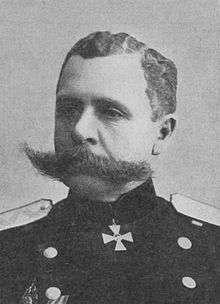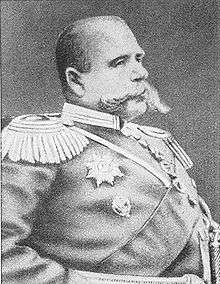Paul von Rennenkampf
| Paul von Rennenkampf | |
|---|---|
 General Paul von Rennenkampf, 1905 | |
| Born |
17 April 1854 Konuvere, Governorate of Estonia, Russian Empire |
| Died |
1 April 1918 (aged 63) Taganrog, Russian Empire |
| Allegiance |
|
| Service/branch | Imperial Russian Army |
| Years of service | 1870–1915 |
| Rank | General of the Cavalry |
| Commands held | Russian First Army (1914) |
| Battles/wars |
Boxer Rebellion Russo-Japanese War World War I |
| Awards | see below |
Paul von Rennenkampf (or Pavel Karlovich Rennenkampf) (17 April 1854 – 1 April 1918) was a Russian general who served in the Imperial Russian Army for over 40 years, including during World War I.
Biography
Early career
Rennenkampf, of Baltic German extraction, was born in 1854 in Konuvere Manor now in Märjamaa Parish, Rapla County, Estonia. He joined the Imperial Russian Army at 19 and attended the Junker Infantry School in Helsinki. He began his military career with the Lithuanian 5th Lancers Regiment. He graduated at the head of his class from the Nikolaevsky Military Academy in St. Petersburg in 1882. He was assigned as a junior officer to the 14th Army Corps until 1884, and to the Warsaw Military District followed by the Kazan Military District to 1886. Rennenkampf was subsequently a senior aide to the headquarters of the Don Cossacks from March 1888, staff officer to the 2nd Army Corps from October 1889, and Chief of Staff of the Osowiec Fortress from March 1890. The same year he was promoted to colonel. From November 1899, Rennenkampf, as chief of staff of the Transbaikalia region, was promoted to major general.
Rennenkampf commanded four infantry battalions, two Cossack sotnias, and two horse batteries, during the Boxer Rebellion in 1900–01, and was responsible for the capture of Tsitsihar and Kirin in Manchuria, thereby removing any Boxer threat to Harbin and the Chinese Eastern Railway. During this campaign, he was decorated with both the 4th degree and 3rd degree Order of St. George for military distinction.

After the rebellion, Rennenkampf was offered a command in the Imperial Guard, but to the Tsar's surprise, he turned it down. He was then given command of the 1st Independent Cavalry Brigade, a post he held until 1904.
Russo-Japanese War
In February 1904, after the outbreak of the Russo-Japanese War, Rennenkampf was appointed commander of the Trans-Baikal Cossack Division.[1] He was promoted to lieutenant general in July 1904, and was wounded in combat in the same month, during the Battle of Motien Pass (10 July 1904), where he was shot in the thigh as he attempted to assist Lieutenant General Fedor Keller halt the advance of Japanese First Army.[1] He remained hospitalized until after the Battle of Liaoyang (August/September 1904).[1] He returned to active service, commanding a cavalry division during the Battle of Shaho (October 1904), and a corps during the Battle of Mukden (February/March 1905). At Mukden, he replaced Major General Mikhail Alekseyev in command of the Russian left flank after a series of defeats and managed to stabilize the situation.[1] However, after the Battle of Mukden, General Alexander Samsonov accused Rennenkampf of failing to assist him during the fighting, and the two quarrelled.
Restoration
After the Russo-Japanese War, Rennenkampf restored part of his reputation dealing with revolutionaries in Siberia as commander of the Seventh Siberian Army Corps. His suppression of the Chita Republic and re-taking of the Trans-Baikal Railroad, which had fallen into the hands of mutinous soldiers led to his promotion to full general in December 1910; however, in following years revolutionaries targeted him for assassination several times.[1] From 1912, he was promoted to Adjutant General and appointed Chief-of-Staff of the Vilno Military District.
World War I
At the start of World War I, Rennenkampf was given command of the Russian First Army for the invasion of East Prussia,[1] advancing from the northeast. His behavior during the Battle of Tannenberg, particularly his failure to coordinate with Alexander Samsonov's Second Army, resulted in much criticism from sector commander General Yakov Zhilinskiy and attempts by some members of the military high command to have him removed from command.
After relative success at the Battle of Gumbinnen in mid-August, failure at the First Battle of the Masurian Lakes that same month, which forced a Russian withdrawal from East Prussia, and at the Battle of Łódź in November 1914, led to Rennenkampf's dismissal amid recriminations of incompetence and even treason (due to his ethnic background). Rennenkampf gave his resignation on 6 October 1915. After the February Revolution of 1917 he was imprisoned in the Peter and Paul Fortress in St. Petersburg by the Russian Provisional Government, who accused Rennenkampf of criminal activities from the start of World War I, including embezzlement and mismanagement.
Arrest and execution
Rennenkampf was set free after the October Revolution and moved to the city of Taganrog on the Azov Sea coast, where he lived under the false name of Mandusakis claiming to be a Greek citizen; however, the ruse was discovered by the Bolsheviks on 16 March 1918. They approached and offered him a command in the Red Army to serve during the Russian Civil War. He refused the offer and was promptly arrested and executed on 1 April 1918 on the personal orders of Vladimir Antonov-Ovseyenko.
Rennenkampf's personal belongings and art objects that he had acquired during the Boxer Rebellion are now displayed in the Alferaki Palace in Taganrog.
Honors
-
 Order of St. George, 4th class
Order of St. George, 4th class -
 Order of St. George, 3rd class
Order of St. George, 3rd class -
Order of St. Stanislaus 3rd degree
-
Order of St. Anne 3rd degree
-
Order of St. Stanislaus 2nd degree
-
Order of St. Anne 2nd degree
-
.png) Order of St Vladimir, 4th degree
Order of St Vladimir, 4th degree -
.png) Order of St Vladimir, 3rd degree
Order of St Vladimir, 3rd degree -
Order of St. Stanislaus 1st degree with swords
-
 Golden Sword of St. George, with diamonds, 1906
Golden Sword of St. George, with diamonds, 1906
References
- Connaughton, R.M (1988). The War of the Rising Sun and the Tumbling Bear – A Military History of the Russo-Japanese War 1904–5, London, ISBN 0-415-00906-5.
- Jukes, Geoffry. The Russo-Japanese War 1904–1905. Osprey Essential Histories. (2002). ISBN 978-1-84176-446-7.
- Kowner, Rotem (2006). Historical Dictionary of the Russo-Japanese War. ISBN 0-8108-4927-5: The Scarecrow Press.
- Warner, Denis & Peggy. The Tide at Sunrise, A History of the Russo-Japanese War 1904–1905. (1975). ISBN 0-7146-5256-3.
Notes
External links
| Wikimedia Commons has media related to Pavel Rennenkampf. |
- biography at Russojapanesewar.com
- Who's Who: Paul von Rennenkampf
-
 "Rennenkampf, Paul". Encyclopædia Britannica (12th ed.). 1922.
"Rennenkampf, Paul". Encyclopædia Britannica (12th ed.). 1922.